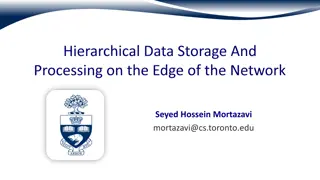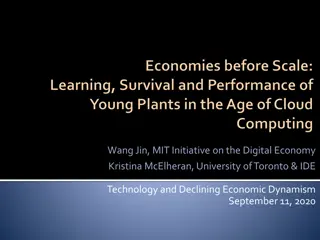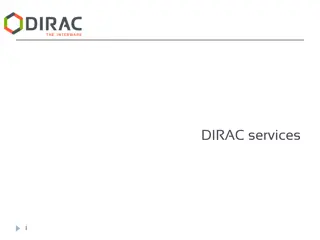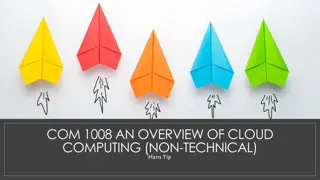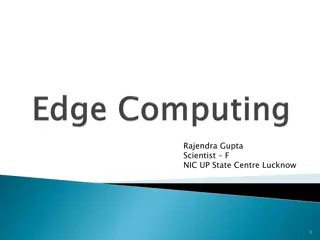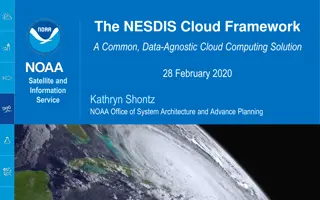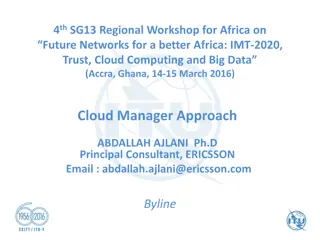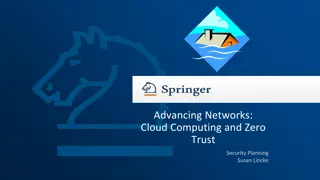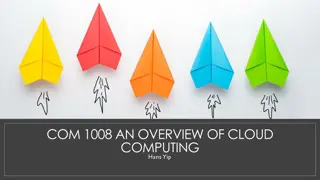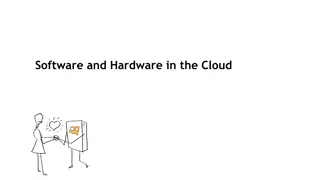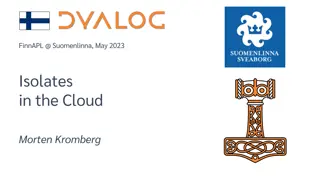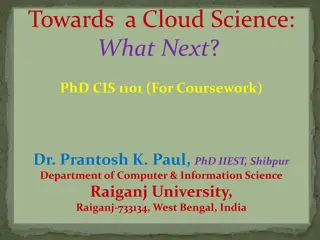Introduction to Big Data Processing in Cloud Computing
Big data processing in cloud computing involves handling large volumes of diverse data quickly and accurately. The lecture covers topics like computing with big data, datafication trends, data volume management, sources of big data, and the characteristics of big versus small data. Understanding the Three Vs (Volume, Velocity, Variety) and adding a focus on Veracity is essential in managing big data effectively.
Download Presentation

Please find below an Image/Link to download the presentation.
The content on the website is provided AS IS for your information and personal use only. It may not be sold, licensed, or shared on other websites without obtaining consent from the author.If you encounter any issues during the download, it is possible that the publisher has removed the file from their server.
You are allowed to download the files provided on this website for personal or commercial use, subject to the condition that they are used lawfully. All files are the property of their respective owners.
The content on the website is provided AS IS for your information and personal use only. It may not be sold, licensed, or shared on other websites without obtaining consent from the author.
E N D
Presentation Transcript
IBIS Innovative Backside Illuminated Single photon imaging sensor INFN Bologna, Tifpa-FBK , Torino P.I.: Alessandro Montanari
Target We want develop a sensor that coupled to an appropriate optics can perfom fast and high- resolution imaging on wide range of wavelengths Ideal sensor: High PDE in VUV (or NIR) Small cell size (High dynamic range) Single photon counting (Low light) High speed Integrated readout Application of our interest: Imaging with scintillation light Liquid Argon detectors Scintillators CSN5 21 September 2020 - IBIS proposal - A.Montanari 2
SiPM standard architecture Quenching resistance Metallic grid SPAD CSN5 21 September 2020 - IBIS proposal - A.Montanari 3
Back illumination Electrical connections and high field region on one side Highest Fill Factor Easier implementation of technical solutions to improve PDE Other side (thinned bulk) free from structures Small size of microcell possible (5-10 um)-> dynamic range Entrance window is free: UV sensitivity SPAD dimension reduceable: High dynamic range SPAD Quenching resistance ROC Electronics can be Integrated in 3D Metallic grid CSN5 21 September 2020 - IBIS proposal - A.Montanari 4
Objective Development of the building blocks of the Back Side Illuminated (BSI) SiPM Microcells (SPAD) size about 10 um Group microcells to form miniSiPMs Pitch of the miniSiPM = 200 um Deliver sensor composed by O(100) miniSiPM Design the Read Out Chip able to copewith 200 um pitch and hosted on active substrate Optimize Front End using Spice models Generate a report on the architecture and technology choice Design database of pixel front-end electronics for the miniSiPM CSN5 21 September 2020 - IBIS proposal - A.Montanari 5
Methodology (1) The cell must be completely redesigned Two learning cycles (runs ,12 wafers and 18 masks) are needed First step in each cycle will be TCAD simulation Ensure proper collection of charge Limit dark count rate Limit optical crosstalk Ensure SPAD proper working in crygenic condition Design SPAD and miniSiPM in conjunction with Front end CSN5 21 September 2020 - IBIS proposal - A.Montanari 6
Methodology (2) Microfabrication process deeply revised for the BSI Start from the front side Remove the bulk and laser annealing Interconnection pads on the front side Test prototypes in FBK and Bologna also in liquid Nitrogen CSN5 21 September 2020 - IBIS proposal - A.Montanari 7
Optics Depend on application: focus on Liquid Argon detectors 1. Coded Aperture Masks: Pin Hole principle infinite Depth of Field 50% of the light is stopped 2. Lens and Fresnel MgF2 or CaF2 Efficiency 50% Aberrations 3. Mirrors Simulation with Ray tracing software CSN5 21 September 2020 - IBIS proposal - A.Montanari 8
Simulation Simulate interaction of radiation in Liquid Argon (and scintillator) Photon generation and propagation (Geant4) Interaction with masks or Lens or Mirror Determine number of photons on sensor -> requirements for photo-sensor CSN5 21 September 2020 - IBIS proposal - A.Montanari 9
WorkPackages WP1: Definition of the requirements Suggested by outcome of WP4 WP2: Sensor development Input from WP1 Co-design done with interactions with WP3 Fabrication of the wafers in FBK Short loops for specific parts will be mandatory WP3: CMOS electronic design Design of architecture done in parallel with WP2 Design of pixel electronics optimized for miniSiPM WP4: Simulation of LAr and Scintillators Simulation with Geant4 of physical processes in LAr Light propagation in Masks/Lens/Mirrors Definition of the pitch, geometry and size of sensor WP5: Characterization of prototypes: Use upgraded test stand Test prototypes mounted on dedicated pcb CSN5 21 September 2020 - IBIS proposal - A.Montanari 10
Timeline CSN5 21 September 2020 - IBIS proposal - A.Montanari 11
Where we are?? One run (12 masks, Nu_at_FNAL) for short loops completed: Study specific critical processes Backside thinning process: Chemical etching procedure found and tuned Two run foreseen for IBIS are under way in parallel since some month Staggered by few month CSN5 21 September 2020 - IBIS proposal - A.Montanari 12
Next steps First prototype from IBIS run 1 will have the new cell design suited for back illumination, BUT will be a front side and available hopefully by end of July 2023 Second protoype from IBIS run 2 will combine new cell and backside illumination after the bulk thinning. First quarter of 2024?? HOW TO PROCEED ?? Propose a new project to CSN5? Call of CSN5 ? ?? CSN5 21 September 2020 - IBIS proposal - A.Montanari 13



